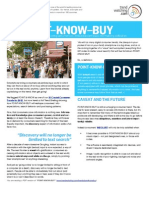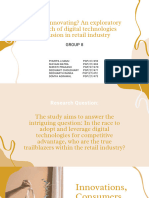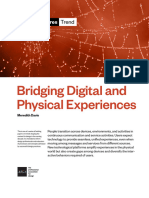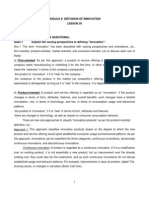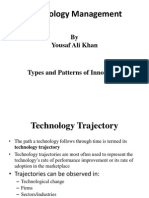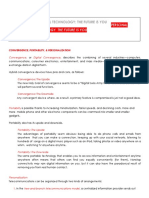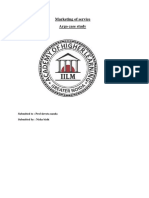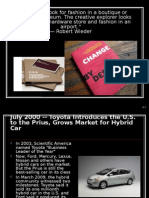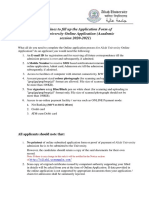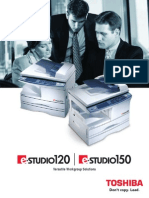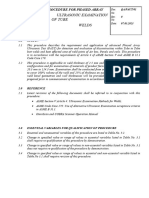Point and Know
Trend analysis in United States
Jef Gandon - MK501 International Consumer Behaviour
�Introduction
Nowadays, mobile phone are everywhere. Smartphones are everywhere to be more precise. For a decade now, a huge majority of people have a tool which allow to make phone calls, but can take pictures, listening music and surf the World Wild Web too. The following report will concern the fact that smartphones influenced consumer behavior in the sense that the easy access of information and the development of smartphones as recording tool developed a trend called Point and Know. We can define the Point and Know trend as the need for instant information and instant access to everything one wants to know. I made the choice to select United States culture as vector of the Point and Know trend because its the country where a lot of information technology innovations take place during the past decades. Furthermore the American culture is based on massive consumption, dynamism and rapidity of services which are important part of this trend. We will see that in the homeland of Google, the way to search the web and get information is not just by tipping a text, but by taking a picture or recording a sound. Regarding my ethno consumerist research on Point and Know phenomenon all the stake was to cover this trend and try to distinguish several profiles associated with verbatim, drivers and recommendations businesses can use to fit this kind of behavior.
� Phenomenon in USA:
Since IBM introduce Simon, the first smartphone ever in 1992, US consumer moved beyond the surprise of a phone doing more than simply making calls. At a minimum, American users expect now the features Simon introduced, along with the ability to play music, take photos, record video, browse the web, and download various application. Using theirs Apples iPhone or others smartphones, people get used to access quick information, by typing on Google or searching on Wikipedia. Following the fast growing of mobile networks and technology products in general, American citizen feel always the need to improve the gain of type performing a search, to use an easier way to perform this search and above all, to receive the most accurate and valuable answers. One the most efficient Point and Know tool used in United State is the QR Codes. They come from Japan where they are used to track automobile parts in Toyotas factories. QR is short for Quick Response codes, because they can be read quickly by a cell phone. They are used to take a piece of information from a transitory media and put it in to a smartphone. QR Codes can be present in a magazine advert, on a billboard, a web page or even on a t-shirt. This code may give details about a business, showing a URL or it may give coupons which can be used in a local outlet. The reason why they are more useful than a standard barcode is that they can store (and digitally present) much more data, including url links, geo coordinates, and text. The other key feature of QR Codes is that instead of requiring a chunky hand-held scanner to scan them, many modern smartphone can scan them. Even if QR codes are more and more used by US consumers (Annex 1), it isnt the only tool which is part of the Point and Know trend. We can cite: Google Goggles: a free image recognition application that enables users to search based on photographs taken with a handheld device. It gives further information about objects, places, and QR and product barcodes. Amazon Flow: an application that enables users to access information about products and purchase them using image recognition. In addition to books, music and film, many household products can also be recognized. Leafsnap: a free app that utilizes visual recognition technology to enable users to identify various species of tree by taking photographs of leaves. WeBIRD: an app that allows anyone with a smartphone to record a birds call, submit it wirelessly to a server and (after a few seconds) receive a positive ID on the species of bird.
Shazam: an app which offers music recognition software that enables users to identify any track they hear, wherever they are, share it and/or buy it. SkinSkan: an app that allows users to keep on track of their health state. Users can take a photo shot of their moles and monitor them to see if they gets bigger later. If it gets bigger, the app will alert user to visit a doctor.
WordLens: an app that lets user translate written phrases simply by pointing phones camera at them. Its not just translating text but in real time in the same font and color so that they fit the original sign shown on your screen.
Finally, we can talk about PittPatt: a facial recognition tool that enables users to find individuals from photographs or videos. The face detection software can locate human faces and match them up with photographs from Facebook and Google Images, identifying individuals in under 60 seconds.
All these services match with the way American people are dealing with technological innovations and tools. In this way, we will analyze this consumer behavior and try to make different consumer profiles.
First consumer category: The up to date
Profile:
The up to date consumer category represent all the people who likes novelties, and who are very influenced by them. Quite young (25-45), this kind of consumer is urban, with upper middle income and is enjoyed about technologies.
Products: As newness is an advantage for them, up to date consumers will be interesting by brand new Point and Know application. He often use Shazam to know what is the song that is passing on the radio and he read all the QR codes he can find in the American ads with his Google Goggles application. These consumers have low involvement, but for them the brands have significant perceived differences. Consumers might switch brands often as they will try a brand and then make their own evaluation. Consumers might choose a new brand based on their evaluation or they might simply get a new product to try something new.
�Drivers: The principal driver that pull consumer to get a Point and Know application is innovation. More than just showing off, up to date consumers are true technologies lovers. They wants to be the first to try a new way to get information, and they want to make it with style. They want to stay informed and are very comfortable with the new needs brought by these tools.
Verbatim: NOVELTY CURIOSITY TREND FASHION MODERN
Second consumer category: The worker
Profile: The worker is a person that use Point and Know technology during his work. He has a job where he has to be mobile, often outdoor, and where he will has to use Information Technologies. He just saw the practical side of this use, and dont take time to use this tools in his private life.
Products: A lot of Point and Know products can be used to work. With the WeBIRD application, an ornithologist can easily determine what the species of birds he hear is. In the same way, with Leafsnap, a botanist can get confirmation about a kind of plant he work on. This kind of consumer has a high involvement in the product because he know effectiveness and the advantages the use of this application bring in his job.
Drivers: The most important driver for this consumer type is the gain of productivity. In the American way to make career, be the most productive and the most efficient worker is the best way to evaluate. These tools can be very practical for that, and the advantage they bring can makes the difference between several workers.
�Verbatim: PRODUCTIVITY USAGES EFFICIENCY CORPORATE TOOLS PROFESSIONAL
Third consumer category: The Occasional Profile: The occasional user is a regular technology user who use Point and Know tools by curiosity first, and who like to use them sometimes. With the development of smartphones, a huge part of the American population can be in this category. Everyone who have the technical possibility of using these tools can have a reason to point Point and Know user. Products: All the Point and Know application can possibly be used by occasional consumer. However, we can say that QR code reader like Google Goggles are more used because of the heavy presence of this technology in American print advertising. The occasional user exhibits little perceived difference between the possible brands and low consumer involvement. Applications like Shazam and WordLense can be popular for occasional users because they respond to punctual needs about a radio song or a word written in a foreign language. Drivers: The drivers for occasional users are curiosity in a first time. They heard about this technology and they want to know how it works and what the benefits of such tools are. In a second time, we can say that another driver is the punctual need, and the rapidity of getting information, everywhere and every time. Verbatim: CURIOSITY PONCTUAL NEED MASS MARKET GADGET
�CONCLUSION
We saw that the Point and know technology can be used by several kinds of American consumer. The fact that a large majority of these applications are free and the big variety of possible usages explain it. People can use Shazam, Google Goggles, WordLense or WeBIRD to be more efficient at work, to get information about the world surrounding them or just to satisfy the need of being trendy. The development of Point and Know application is growing very fast in USA, the objective is to bring quick response to everyday needs. We just a phone, consumer will be capable of interact with theirs environment for getting information about everything, every time, everywhere. The Point and Know trend is just at his beginning, but Im sure it will become a huge success and can become a standard about how people looking for information in United States. That is for a simple reason: its the best answer to the American way of living and working. In other words to be quick, efficient, mobile, and entertaining.
�BIBLIOGRAPHY
Manjoo, F 2012, 'You Will Want Google Goggles', Technology Review, 115, 4, pp. 72-74, Business Source Complete, EBSCOhost, viewed 19 November 2012.
Gurpreet Dhillon, David Coss, Ray Hackney, (2001) "Interpreting the role of disruptive technologies in e-businesses", Logistics Information Management, Vol. 14 Iss: 1/2, pp.163 171
Anthes, G 2011, 'Invasion of the Mobile Apps', Communications Of The ACM, 54, 9, pp. 16-18, Business Source Complete, EBSCOhost, viewed 19 November 2012.
'THE SHAZAM MUSIC RECOGNITION SERVICE' 2006, Communications Of The ACM, 49, 8, pp. 44-48, Business Source Complete, EBSCOhost, viewed 19 November 2012.
Content-based classification, search, and retrieval of audio; Wold, E.; Blum, T.; Keislar, D.; Wheaton, J. IEEE Multimedia); Fall 1996 Vol. 3, 10p.
Savage, N 2011, 'Sorting Through Photos', Communications Of The ACM, 54, 5, pp. 13-15, Business Source Complete, EBSCOhost, viewed 19 November 2012.
Wagner, J 2011, 'ANYTIME/ANYWHERE -- PLAYING CATCH UP WITH THE MIND OF THE SMARTPHONE CONSUMER', International Journal Of Mobile Marketing, 6, 1, pp. 28-53, Business Source Complete, EBSCOhost, viewed 19 November 2012.
�ANNEX 1 Independent Research conducted through the CMB Consumer Pulse by Jeff McKenna and Jennifer Sage
